I would add here the giant iPhone aka iPad. But this is an intentional flop as they limit its usability on purpose with the mobile operating system to make money through the App Store.
Got a tip for us?
Let us know
Become a MacRumors Supporter for $50/year with no ads, ability to filter front page stories, and private forums.
Apple's Biggest Hardware Flops of All Time
- Thread starter MacRumors
- Start date
- Sort by reaction score
You are using an out of date browser. It may not display this or other websites correctly.
You should upgrade or use an alternative browser.
You should upgrade or use an alternative browser.
The other way to look at it is a seamless experience with the iPhone but bigger more usable display. If the functionality of the iPad doesn’t suit you, don’t buy it.I would add here the giant iPhone aka iPad. But this is an intentional flop as they limit its usability on purpose with the mobile operating system to make money through the App Store.
Would like to use the iPad but can’t fully take advantage since it’s limited by design. I have a bunch of other Apple products that integrate nicely but the limited usability of the iPad is very annoying. That’s why I call it a giant iPhone.The other way to look at it is a seamless experience with the iPhone but bigger more usable display. If the functionality of the iPad doesn’t suit you, don’t buy it.
What’s even more bizarre is that instead of making the iPad more like a computer now they are making the computer more like an iPad with Ventura.
Honestly the iPad is great at what it does. My mom has one and has had one for a number of years now. She can chat with people (Zoom/FaceTime etc), check her email, play games, post to social media etc. For her, anything more than that is overkill. She doesn't need a desktop or laptop when her iPad does what she needs it to do.The other way to look at it is a seamless experience with the iPhone but bigger more usable display. If the functionality of the iPad doesn’t suit you, don’t buy it.
That to me is the genious of the iPad - simplicity
The design choice resembles a dead mouse with its tail up stiff. Not sure if some humour was behind the design choice.I have the Magic Mouse. It is typically charged once a month. Having the port underneath would be unusual if it needed recharging every couple of days. Charge it overnight and who cares if the port is underneath and it doesn’t take that long to charge from 0 - 100…maybe a couple of hours
Despite this, starting at just shy of ten grand (around $29,905 by today's standards), the Lisa was prohibitively expensive for all but the wealthiest of households, and the computer was a flop.
Reminds me of this:
Hold on the pundit is comparing it to Bose, what is this sarcasm 😝The 2006 iPod Hi-Fi is widely know as one of the biggest flops in regards to speaker systems.

Steve was trying to claim it represented home stereo reinvented, compared to a pair of powered speakers or a home audio setup. Problem was there was zilch stereo imaging as the speakers were too close together. He literarily arranged for all competing traditional computer speakers to be removed from the retail Apple stores to coax consumers into buying this 15 pound speaker solution.

from a review
Apple's entry into the "hi-fi" speaker market has not been met without skepticism. After all, the iPod Hi-Fi's marketing materials would leave one to wonder if Apple has simply never heard of customers using their iPods with anything other than the bundled earphones. The premium pricing doesn't seem to help matters either; at $350, the iPod Hi-Fi is up there with the most expensive iPod speaker systems. Pundits may cry, "Who does Apple think they are, Bose?" Of course not Apple which says almost as much about the iPod Hi-Fi as any review in its entirety could.
As noted most of Apple’s ”premium” speaker system offerings are overpriced. Now it’s debatable if it sounds decent as that depends on many variables such as room size, placement, hearing of the individual, experience of quality by said individual, what genre of music being played, encoding, etc.
iPod HiFi was an oversized and priced sound bar with a 30pin dock connector. At the time I wanted to get my hands on one to hear it in my dwelling but it was discontinued. The HiFi was best suited for a teenagers small room but had the price of an employed adult with a decent income to spare. HomePod suffered similar but Apple learnt from the HiFi ordeal but crippled it with other issues.
It will be exciting to see the grid of app icons in the goggles, like the grid of app icons in Apple TV, like the grid of app icons in the Apple Watch… Maybe it will have a touchbar… truly exciting times.Apple will do it right, everyone else rushed to the market, Apple studies and design to work with the iOS ecosystem which is the advantage most other platform do not have
My point wasn’t that. My point is that, under Cook, Apple is more likely to create cheaper versions to reach more people. Under Jobs, there was no “SE”. So a cheaper version of the AR headset is more likely. Of course, this also means having more expensive products on the other end of the spectrum.
Cook had to make SE iPhones because he nearly doubled the cost of the flagship iPhone. Don’t forget that a base storage, full featured iPhone 3, 3GS, 4, 4s, 5, 6, 6s(?) was US $650.
I use a trusty AA battery powered one. No wires, no problems, very light kit with an actual tiny on/off slider switch. And yes it's on the bottom.
Utter garbage mouse. Disconnects if jostled because batteries shift. Had to put a piece of duct tape in the battery compartment and still had frequent disconnects.
What is a “clit mouse” and where can I buy one?And as horrible as this mouse was, the clit mouse and the hockey puck one were worse.
I genuinely do not understand the issue some people have with the Magic Mouse. I’ve been using one for years and have never had anything but excellent experiences with it. Can you tell me in what ways it disappoints?
Mine has been wholly unreliable, like it was someone’s school project. I finally gave up on it and switched to a $25 Microsoft mouse and couldn’t be happier. Uses less batteries, less often, too.
Lacks symmetry, if it was a human maybe it would have been attractive but it does not work on an inanimate object. The iMac with a chin resembles a human face looking back at you in a friendly cute way. The Luxx lamp iMac resembled a daisy flower in a pot and it was symmetry the CD/DVD drive resembled a smiley face with a mischievous tongue sticking out when ejected.The Apple Lisa is one of the neatest looking computers I've ever seen. Almost straight out of 2001: A Space Odyssey. The fact that it was expensive was its downfall. But it ran a multi-tasking operating system, featured an internal hard disk and up to 2MB of protected memory - features the Mac wouldn't get for years. The chassis with the logic board and expansion cards slides right out the back, similar to the Mac Pro of 25 years later.
I think they're beautiful machines. Oh, and they could run Mac OS... faster and better than its relatively underpowered and cheaper successor, the Macintosh.
View attachment 2142110
Apple used to humanism its product design especially the iMac. The OG resembled a head in profile and the Finder face on boot up screen. The translucent resembled the inner workings of the computer mind. Even the OG PowerBook G3 had curves with black on black tones and different texture as it could be used by any gender for its time. The iBook resembled a curvy bag or purse with a built-in handle and hard candy colour options. Later designs got cold and industrial looking as Apple wanted to cater to a professional market. Colours seemed playful, fun, not professional in the hardware marketing world. OS X Aqua looked lickable delicious but toned down due to GPU complexity and UX issues with certain age groups.
The Cube evolved into the MacMini and Studio, but with the M series chips it’s ripe to be re-introduced.I always liked the look of the cube, but sadly it was released long before I was old enough to be able to get one on my own. And the price was certainly too high to be a birthday or Xmas gift.
And like a lot of older Apple hardware, while I could get one now just for the sake of it and nostalgia, it would be one more trinket lying around and a fair chunk of change lost for a momentary high.
In the hardware design market, Apple is one of the few leaders and innovators. Instead of hiding that case under a desk like majority PC‘s, Apple wanted to showcase design and marketing. I liked the Cube and TrashCan design as it was innovation in design but the hardware limited.Great article, I didn’t actually know about most of these.
And now that I know that Schiller was the one defending the cube, his “can’t innovate anymore my ass” comment is even more ironic. That damn trashcan wasn’t even innovation. It was just a slightly modified version of something that he personally saw them try and fail. And then he learned nothing.
The circular mouse with the iMac though not ergonomic it was unique, memorable for its opposing design direction and it was meant to feel like a friendly handshake.Not a single mention of EVERY BLOODY AWFUL MOUSE that Apple has produced...
I agree the Apple CinemaDisplay was designed after an artists painting tripod stand. It was limited in the angles but it looked great with the pinstripe bezels. I wanted the 30” ACD but I could not afford it on a students budget. Apple‘s hardware design went industrial and it lost its memorable friendly appeal.Even the “flops” were innovative, and many of them probably commercially successful to boot.
I still have several of these machines laying around taking up space and mind space. My fave is the Cube and the cube monitor. “Rip Mix Burn”ed a lot of CDs with that bad boy.
Say hello to xrOS!Yes, the GUI was a milestone of human progress in management and actualization of information - as if that had entered into another dimension.

The 84 biggest flops, fails, and dead dreams of the decade in tech
Some of these ideas caught fire — but not in the ways their creators hoped.
 www.theverge.com
www.theverge.com

The 84 biggest flops, fails, and dead dreams of the decade in tech
Some of these ideas caught fire — but not in the ways their creators hoped.

12 of Google's Most Embarrassing Product Failures
Stuffed with social platforms and gadgets, Google's graveyard is bigger than you might expect.

Killed by Google
Killed by Google is the open source list of dead Google products, services, and devices. It serves as a tribute and memorial of beloved services and products killed by Google.

Google Cemetery: Learn from Google's +100 Failures
Learn from Google's +100 failures to build profitable businesses and scale acquired companies.
Android Authority: Tech Reviews, News, Buyer's Guides, Deals, How-To
Your source for the best phones, streaming, apps, headphones, deals, games, Chromebooks, smart home tech, and more.
www.androidauthority.com

The 30 Biggest Failed Google Products Up To 2023
Google is one of the most successful companies in the world. Yet, many of the products they've launched failed. Here are their 30 biggest failures.
 www.failory.com
www.failory.com

The 30 Biggest Failed Google Products Up To 2023
Google is one of the most successful companies in the world. Yet, many of the products they've launched failed. Here are their 30 biggest failures.

Complete list of products by Google that failed miserably
Just like any other successful company – Google has also faced its fair share of loss and product failure. Here is a list of products by Google that failed to make their mark with the users.
These lists put the MacRumors article in context.
Last edited:
Imagine if Apple produced a pyramid designed MacStudio stackable design where a customer could add more layers to the base for functionality and design on the desk, that would be sick/cool to display.Add to the list:
-Ping
-Magic Mouse with charging port on the bottom.
-USB-C only Macbook Pros
-Apple Music GUI
-That daft touch bar thing.
-The trash can and it 50 Dongles.
The iMac luxo lamp design is a beloved classic design, it even beats the OG iMac and the present. I think that design made into into a museum.Old tech is so hideous to look at.
The design choice resembles a dead mouse with its tail up stiff. Not sure if some humour was behind the design choice.
The charging port on the bottom has never bothered me. I enjoy the mouse every day. After all, 90% of the mouse's life (when I use this mouse) I prefer the touch surface without notch, so this compromise not only looks aesthetically but also functionally well balanced. How would you have done it better? I'd be really interested to know. Maybe draw it and post it in here.
Since there are a lot of people here at MacRumors who like to park charging mats for all products on the table, they might be happy to have a soft mattress gimmick for their mouse to rest on while lying on its back.
On the other hand, Apple has used a hard plastic for the sensitive surface that normally does not scratch.
"Apple even told customers to lift their machine several inches above their desks and then drop it to reseat them.
And we thought "You're holding it wrong" was crazy.
It seems the word "overpriced" has been associated with Apple products since the very beginning.
And we thought "You're holding it wrong" was crazy.
It seems the word "overpriced" has been associated with Apple products since the very beginning.
Fully agree. I completed my master thesis in industrial control systems on the MP2100 (with the external keyboard but the handwriting recognition did work surprisingly well). Fantastic device.My Newton 2100 was one of my favorite tech devices of all time. Jobs was too quick to kill it.
TheYayAreaLiving 🎗️
Suspended
Found a list of Apple products that were killed by Apple just in 2022.


Did you own any of these products? What did you think of them at the time?
These days Apple is associated with the iPod, iPhone, iPad, MacBook – game-changing products so wildly successful that they have changed the way we live. But even the most valuable company in the world has had its fair share of marketing missteps and hardware blunders.

Apple wasn't always as profitable as it is today, and the failure of some of its earlier products would have doomed most other tech companies to the annals of history. Here we take a look back at some of Apple's most infamous hardware flops. See if you agree, and let us know in the comments of any other questionable Apple devices that you think deserve to be named and shamed.
Apple III
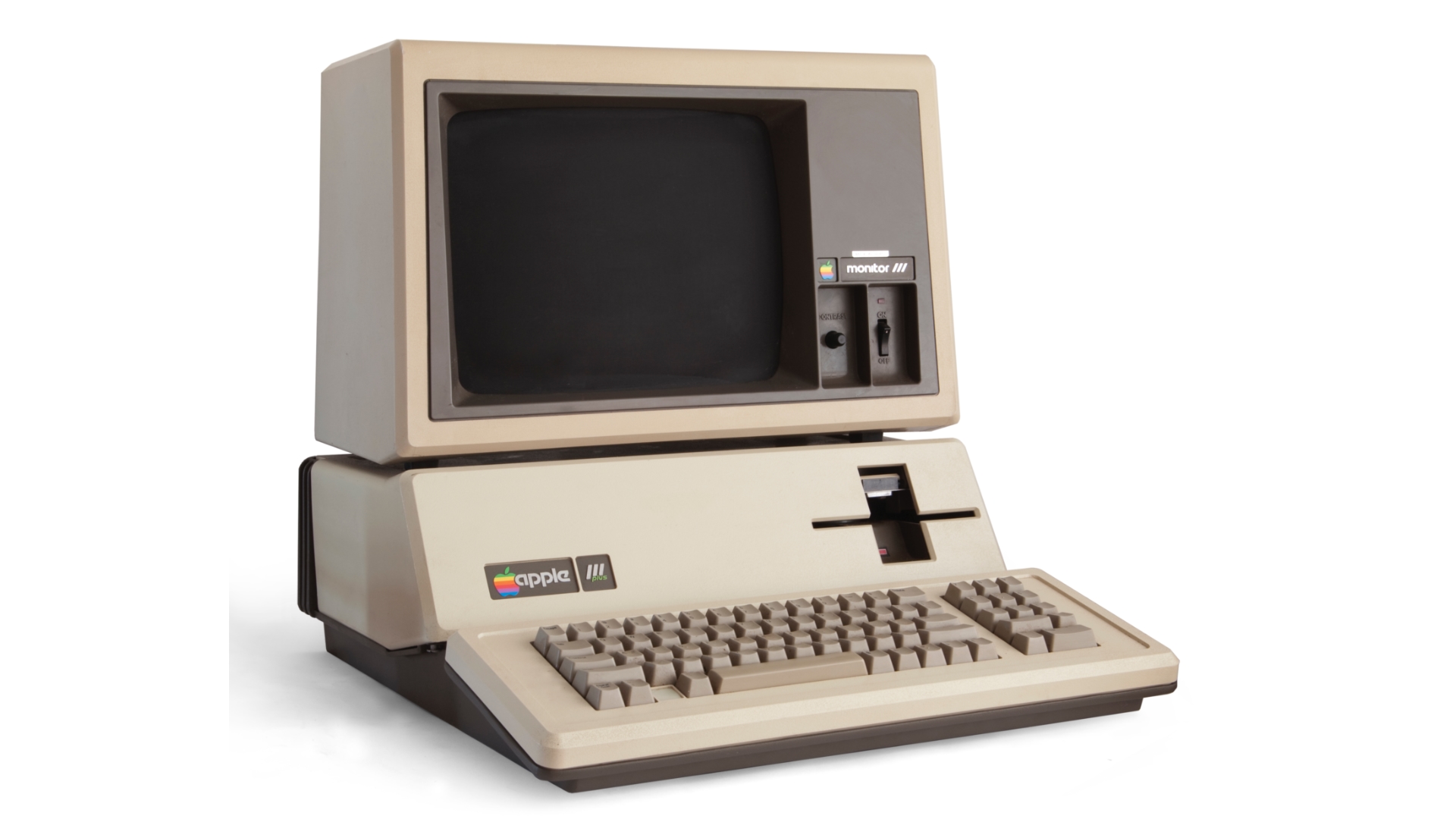
The Apple III was the result of a project initiated in 1978 after Apple became concerned that the popularity of its Apple II, launched in 1977, would eventually wane. Originally built with hobbyists in mind, the Apple II was surprisingly popular with small businesses, but Apple was aware that IBM was working on a personal computer specifically aimed at business users, which only made Apple more eager to consolidate its hold on the market. The Apple III therefore had to be the complete system – all things to all users – and a cost-effective addition to any office or home.
A committee of engineers was assigned to the Apple III project, making it the first Apple computer not designed by Steve Wozniak. As it turned out, everyone had their own ideas about what features the Apple III should have, and all of them were included. The project was supposed to be finished in 10 months, but ended up taking two years as a result.
In November 1980 the Apple III finally launched, starting at an eye-watering $3,495, and offering twice the performance as the Apple II and twice as much memory (128KB of RAM). It was the first Apple computer to have a built-in floppy drive, and ran a new operating system called Apple SOS, featuring an advanced memory management system and a hierarchical file system.
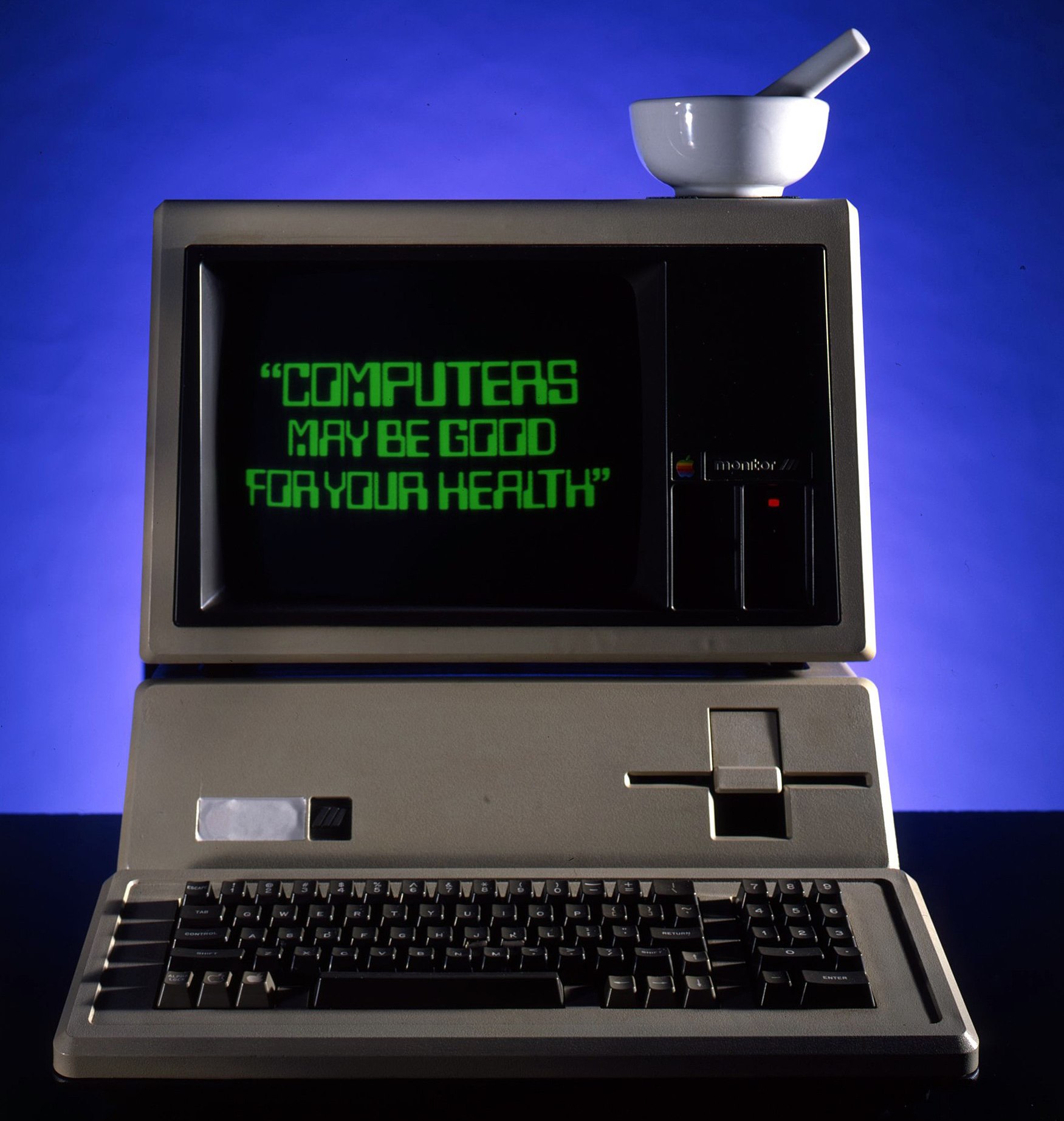
An ad for access to health information via the Apple III
Unfortunately, none of these innovations could save the Apple III from its flawed chassis design, and Apple was forced to recall the first 14,000 machines produced due to serious overheating issues, caused in part by Steve Jobs' insistence on not including a fan in the case. The problem was so bad that thermal expansion would often cause the chips to pop out of place. Apple even told customers to lift their machine several inches above their desks and then drop it to reseat them. A revised model under the name Apple III Plus was eventually released in 1983 that addressed the widespread failures, but the damage to the computer's reputation had already been done.
The Apple III was discontinued in April 1984, while its successor was dropped from Apple's product line in September 1985. The company sold an estimated 65,000–75,000 Apple III computers, with the Apple III Plus taking the total up to around 120,000. Jobs later said that the company lost "infinite, incalculable amounts" of money on the Apple III, and its poor reception caused thousands of US businesses to buy IBM PCs instead.
Apple Lisa
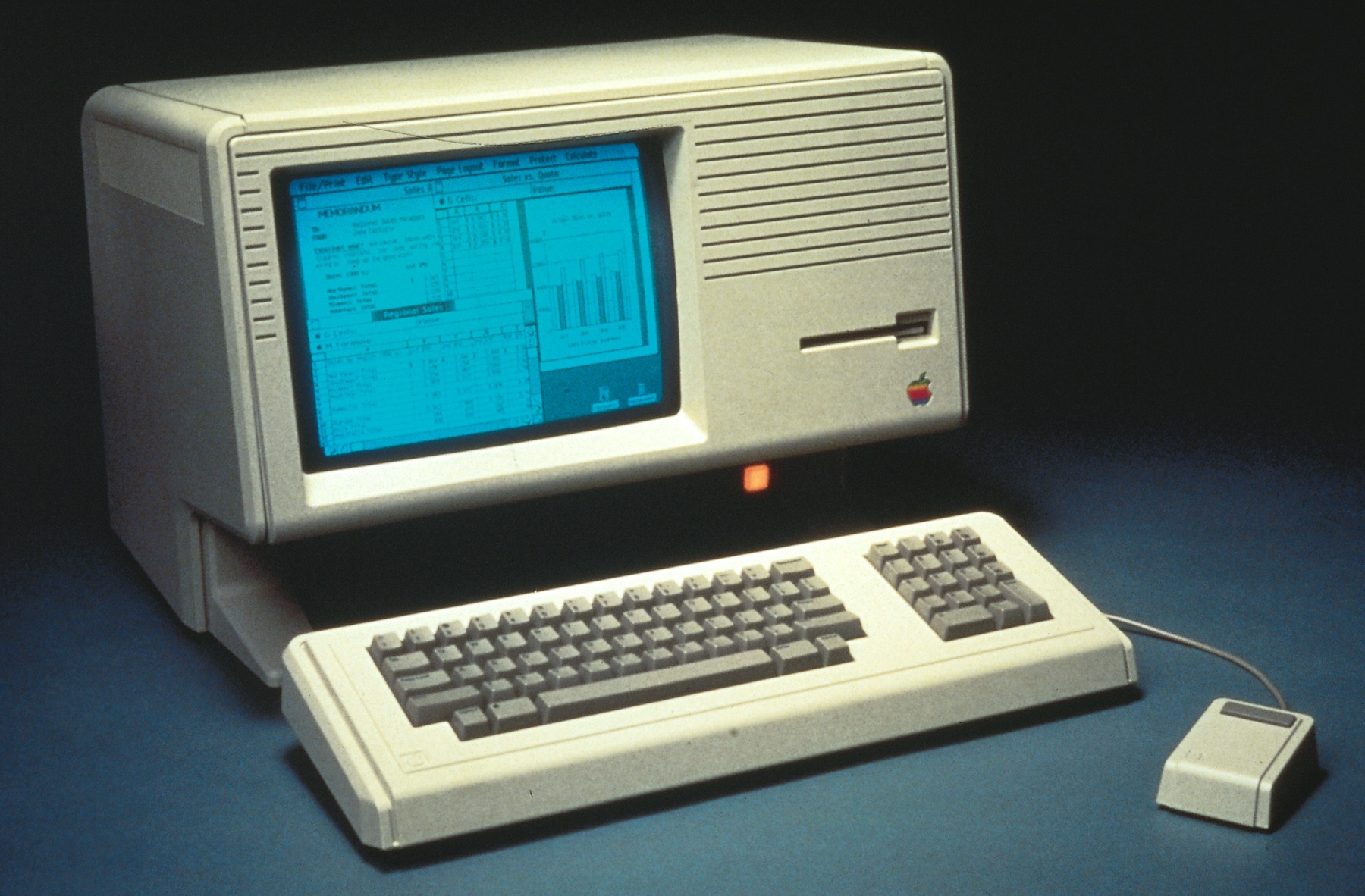
Released in 1983, Lisa officially stood for "Local Integrated Software Architecture," but was actually a backronym invented later to fit the name of Steve Jobs' daughter, Lisa. Apple positioned it as a business computer and an alternative to the Apple II. While previous computers relied on text-based interfaces and keyboard input, Lisa was the first personal computer to feature a graphical UI and mouse, interface innovations both first seen in action by Jobs during a visit to Xerox Parc's research lab in Silicon Valley.
Despite this, starting at just shy of ten grand (around $29,905 by today's standards), the Lisa was prohibitively expensive for all but the wealthiest of households, and the computer was a flop. By 1986, Apple had only managed to sell around 100,000 units, and the entire Lisa platform was discontinued. Apple was even forced to dispose of some 2,700 Lisas in a landfill in Utah. Fewer than 100 Lisa computers are believed to exist today.
Apple Lisa commercial starring Kevin Costner
Looking back, Jobs felt that Apple had lost its way. "First of all, it was too expensive — about ten grand," he said in an interview with Playboy in 1985. "We had gotten Fortune 500-itis, trying to sell to those huge corporations, when our roots were selling to people." Jobs actually got kicked off the Lisa project in September 1980 because of his volatile temperament, but as fate would have it, he subsequently joined the team that ended up developing the first Macintosh.
Apple Newton
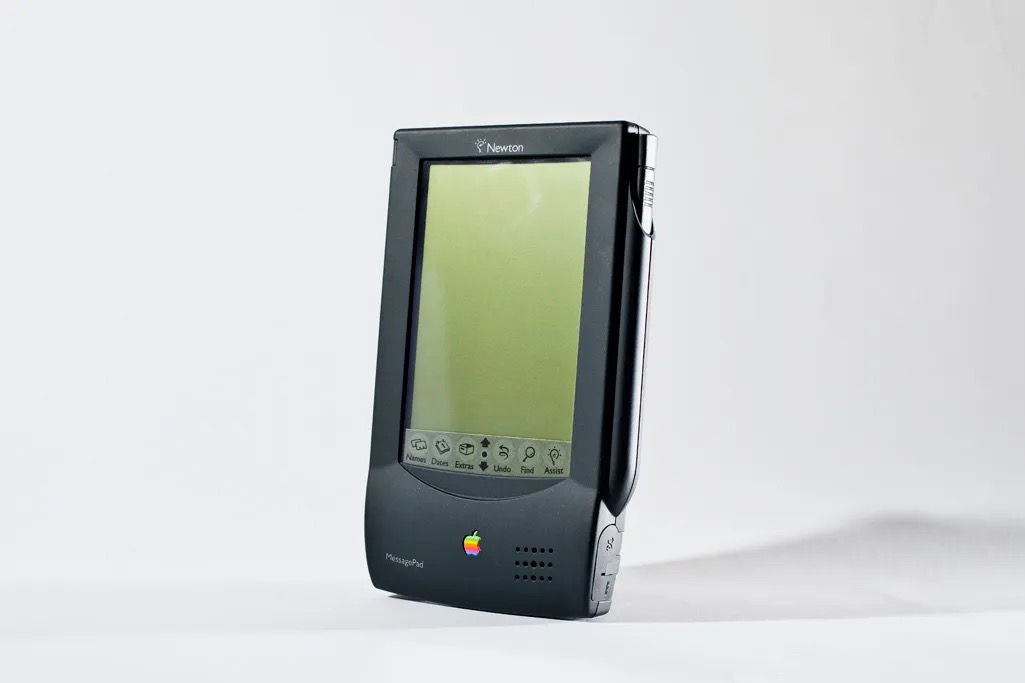
In May 1992, Apple CEO John Sculley unveiled the Newton MessagePad to a rapt CES audience. He called the sleek black handheld gadget, which was about the size of a VHS cassette, a Personal Digital Assistant (PDA). The Newton PDA, he said, was a completely new category of device. It came with a stylus and could be used to take notes, store contacts, and manage calendars – standard functions of any modern-day smartphone, but revolutionary in 1993. Users could take it out, send a fax, and return it to their pocket, without ever going near a desktop computer.
The truly killer feature, however, was its handwriting recognition. Or at least, that was Apple's original plan. What the audience didn't know was that it barely worked. Apple shipped the first Newton MessagePad 14 months later for $900, but by that time other companies had already rushed rival PDAs to market, and the Newton still had big problems translating handwritten notes into text. After the negative reviews, it was widely derided in the media – the comic strip Doonesbury dedicated a whole week to lampooning its handwriting recognition issues, and the device even became the butt of a joke in The Simpsons.

Doonesbury comic strip lampooning the Newton (Image credit: Universal Press Syndicate)
Apple battled to make successive versions of the Newton a success, and with the release of Newton OS 2.0 in March 1996 the handwriting recognition had been substantially improved. But it was too little, too late. The brand just couldn't shake its abysmal debut performance. Worse, Steve Jobs hated it, for two reasons: It came with a stylus ("God gave us ten styluses," Jobs would say, "Let's not invent another.") and it had been Sculley's pet project. Upon his return to Apple in 1997, Jobs pushed for the product line be killed off. It was discontinued a year later.
"Lisa On Ice": Episode of The Simpsons making fun of Apple's Newton
Newton went through eight versions of the hardware, with Apple spending $100 million on its development. Only an estimated 200,000 were ever sold. But it wasn't all a waste. The same thinking behind the PDA would eventually bring us the iPhone.
Macintosh TV
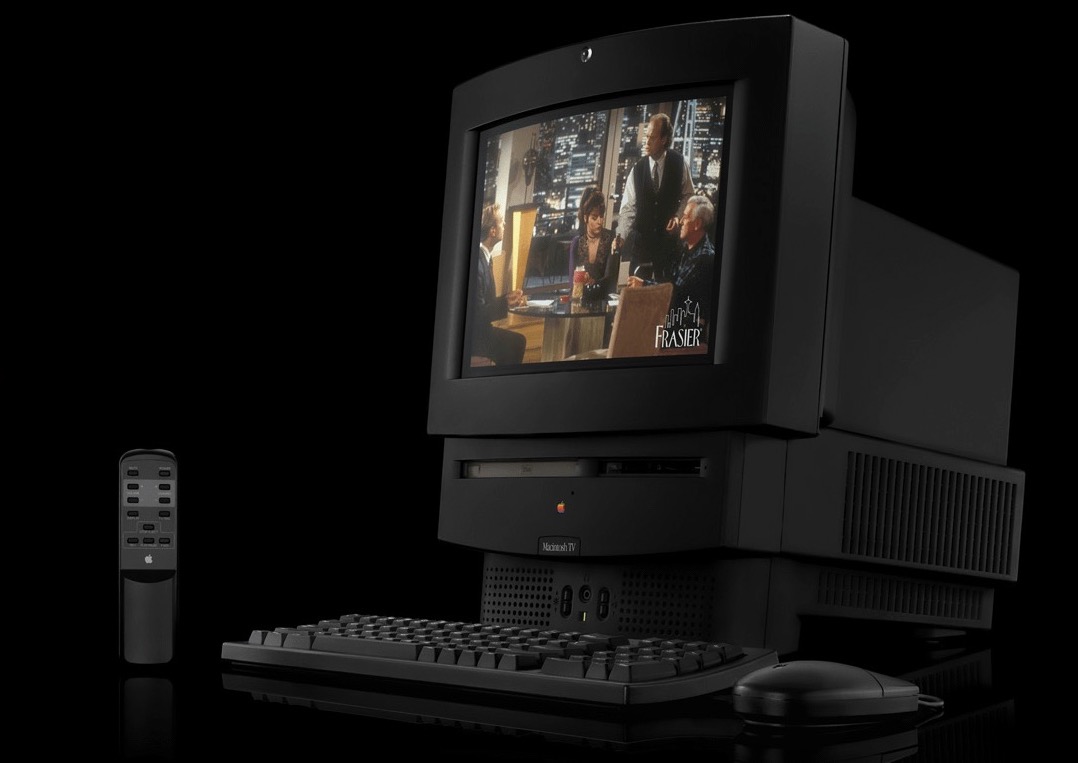
In an age where watching streaming video on your phone or PC doesn't even raise an eyebrow, Apple's original computer-television hybrid now seems like a solution in search of a problem. But when it launched in 1993, the idea of watching TV on your Mac was completely ahead of its time.
The black chassis of the Macintosh TV was essentially an LC 520 fused with a 14-inch Sony Trinitron CRT. It came with a CD-ROM drive and remote control, while a built-in tuner card with connecting coax cable allowed broadcasts to be displayed in 16-bit color. Unfortunately, users had to choose to either watch TV or use their Mac. It couldn't display TV in a window (Picture in Picture hadn't been invented yet) and it was impossible to capture video, although users could save still frames of broadcasts as PICT files.
On the face of it, the Macintosh TV offered faster performance than the standalone LC 520, thanks to a 32MHz Motorola 68030 processor. In reality though it was bottlenecked by a 16MHz bus. Also, the 5MB of RAM was only upgradeable to 8MB, whereas the LC 520 could max out at 36MB. Costing $2,099 at launch, Apple's TV-Mac mashup was not cheap, and it failed to catch on. It was discontinued in 1995, two years after its release, by which time Apple had shipped just 10,000 units.
Pippin
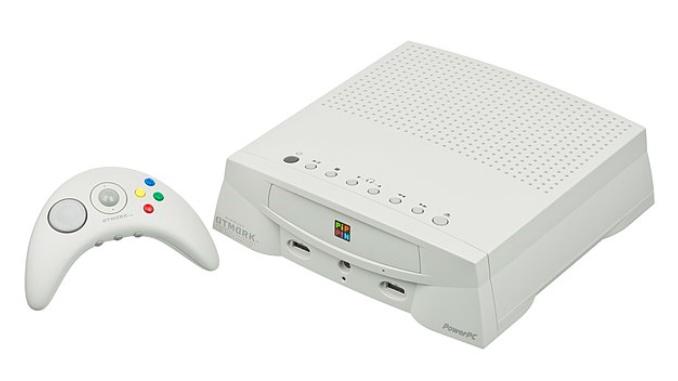
Launched in 1996 with the help of Japanese game company Bandai, the Pippin was Apple's infamous stab at a CD-ROM based game console, but it was badly marketed, poorly supported, and vastly overpriced. The Pippin arrived at the height of the console wars, a time when home computers had yet to become commonplace. Apple's ill-fated plan was to shift the market dynamic with a hybrid computing/gaming device.
On the face of it, the Pippin was just that, boasting some unique features that all other console rivals lacked. Based on Macintosh architecture from the early-to-mid '90s, the Pippin ran a simplified version of Mac OS 7, making it faster than other consoles. It was also equipped with a veritable selection of ports, supporting not only modem and printer connections, but also offering users the ability to connect external peripherals like keyboards and mice.
Unfortunately, Apple's intention to give Pippin users a computer-like experience in a console form factor was partly the reason for its downfall. Costing $650, the Pippin was around $400 more expensive than leading rivals such as the PlayStation and Nintendo 64. And despite Pippin's fast performance, competing consoles had the edge in terms of software, with many sporting extensive games catalogs, whereas only 25 titles were released for Pippin owing to poor third-party developer support on the part of Bandai, a relatively unknown name among the gaming community.

Apple didn't plan to release Pippin on its own, intending to make the platform an open standard by licensing the technology to third parties, similar to its licensed Mac clone program in the late '90s. However, when Steve Jobs returned to Apple in 1997, he canned the company's clone efforts and subsequently shut down Pippin development, leading Bandai to halt the production of all models of Pippin by mid-1997. Apple had hoped to ship half a million consoles a year, but only sold a total of around 42,000 in the device's short lifespan.
20th Anniversary Macintosh

Released in March 1997 to mark Apple's 20th year in business rather than the anniversary of the Mac, the "20th Anniversary Macintosh," or TAM as it became known, might look odd by today's standards, but it was a unique machine in its own right.
Its strikingly thin and upright "all-in-one" design housed several novel features, including a built-in 12.1-inch LCD flat-screen display, vertically mounted CD-ROM and floppy drives, and an integrated TV/FM tuner. The TAM ran a modified version of Mac OS 7.6.1 to control these features, while a 250MHz PowerPC 603e CPU and 64MB of RAM ensured performance was nothing to sniff at. It even had a custom Bose sound system with two accompanying speakers and a subwoofer built into the external power supply.
TV commercial for 20th Anniversary Macintosh
Delivered to customers via a direct-to-door service undertaken by tuxedoed concierges, the TAM was marketed as an executive machine, but at $7,500, the executive pricing proved too much of a turn-off, and sales were poor. In the final weeks of its availability, Apple slashed the price of the TAM to $2,000, but this only served to anger people who had paid full price, and Apple was forced to reimburse early adopters with a new PowerBook.
Only 12,000 TAMs were made, many of which were never sold. The system lasted barely 12 months in Apple's product lineup and was discontinued a year later in March 1998, shortly before the launch of the iMac G3, which offered similar specs but a larger screen, and all for just $1,299.
Power Mac G4 Cube

Unveiled on July 19, 2000, the Power Mac G4 Cube was an engineering marvel and a statement piece of Apple industrial design. At less than one fourth the size of most PCs available at the time, the fanless machine represented an entirely new class of computer, featuring a powerful G4 PowerPC processor, discrete Nvidia video card, AirPort card for Wi-Fi, and a DVD burner, all packed neatly into an elegant eight-inch cube suspended inside a transparent molded acrylic case. Steve Jobs called it "simply the coolest computer ever," and going on first impressions, it was hard to disagree.
But the Cube was doomed almost from the start. Upgradability was limited – a handle in the bottom of the Cube allowed users to pull the innards out of the case, providing access to three RAM slots and space to insert an AirPort card, but there were no PCI slots and the proprietary video card was shrunken down to fit into the tightly enclosed space. It was also too expensive, even by Apple's standards. The lowest-priced model cost $1,799, which was $200 more than the far more upgradeable Power Mac G4.
Apple promotional video for Power Mac G4 Cube
Apple sold fewer than 150,000 units in 349 days, and on July 3, 2001, Apple announced it was suspending production of the Cube indefinitely. "Cube owners love their Cubes," said Phil Schiller, Apple's then vice president of product marketing. "But most customers decided to buy our powerful Power Mac G4 minitowers instead." Apple CEO Tim Cook would later describe the G4 Cube as "a spectacular failure."
Article Link: Apple's Biggest Hardware Flops of All Time
My Newton 2100 was one of my favorite tech devices of all time. Jobs was too quick to kill it.
Would not have fit aesthetically in the era of translucent Macs like iMac G3, Power Mac G4 and PowerBook G4 and soon after they had already began research on iOS.
Imagine if Apple produced a pyramid designed MacStudio stackable design where a customer could add more layers to the base for functionality and design on the desk, that would be sick/cool to display.
ACER did something like that and it is an ugly flop and every connection for each module is a potential point of mechanical and software failure.

I can already tell it’s going to be too expensive and the regular consumers will be complaining. Honestly, it looks cool for 5 minutes but that fades away really fast.
Great concept but not meant for reality.
That's sad that he can't memorize a workout and needs a video overlay to remind himself in a park of all places. AR concept use case videos always suck so bad. It's always 'Throw your brain away and let this flashy thing think for you'.
Register on MacRumors! This sidebar will go away, and you'll see fewer ads.


